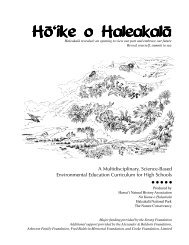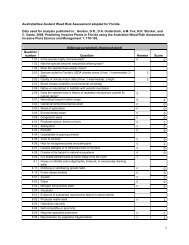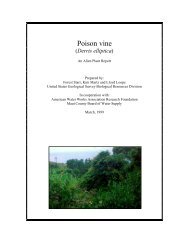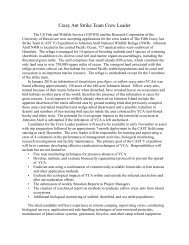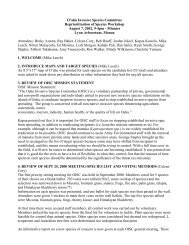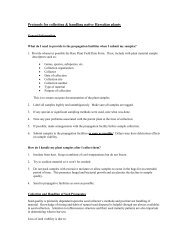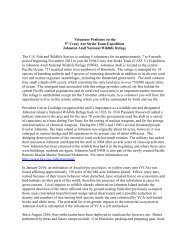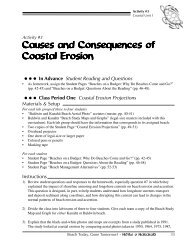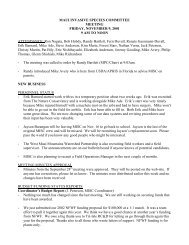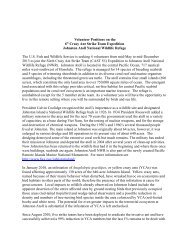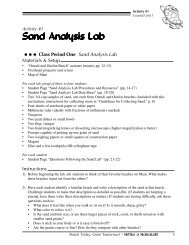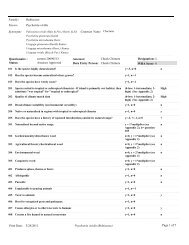Invasive plant species on Kosrae, Federated States of Micronesia
Invasive plant species on Kosrae, Federated States of Micronesia
Invasive plant species on Kosrae, Federated States of Micronesia
Create successful ePaper yourself
Turn your PDF publications into a flip-book with our unique Google optimized e-Paper software.
2. Species that are invasive elsewhere and are likewise invasive or have the potential to<br />
become so <strong>on</strong> <strong>Kosrae</strong><br />
Some known invasive <str<strong>on</strong>g>plant</str<strong>on</strong>g>s that are causing trouble in similar ecosystems have been introduced<br />
into <strong>Kosrae</strong> (Appendix 2, Table 2). Some <strong>of</strong> them are already causing problems while others are<br />
not. Some are cultivated <str<strong>on</strong>g>plant</str<strong>on</strong>g>s that have not (yet) escaped and their potential for causing<br />
damage is so far unknown. However, <strong>on</strong>e <strong>of</strong> the best predictors <strong>of</strong> invasiveness is the behavior<br />
<strong>of</strong> the <str<strong>on</strong>g>species</str<strong>on</strong>g> elsewhere, and these are known troublemakers.<br />
Adenanthera pav<strong>on</strong>ina (the coral bean tree), invasive in sec<strong>on</strong>dary forests and already<br />
widespread <strong>on</strong> <strong>Kosrae</strong>.<br />
Chromolaena odorata (Siam weed), a highly invasive pan-tropical weed. It will likely become<br />
even more widespread over time. Biological c<strong>on</strong>trols are available that are effective in open<br />
areas, less so in shaded stands. On <strong>Kosrae</strong> it is likely to follow new developments such as roads.<br />
Clerodendrum quadriloculare is suspicious because it appears to have the ability to invade intact<br />
or relatively intact native forests. This <str<strong>on</strong>g>species</str<strong>on</strong>g> is notorious for being a prolific producer <strong>of</strong> root<br />
suckers and in fact the <str<strong>on</strong>g>plant</str<strong>on</strong>g> is easily propagated by means <strong>of</strong> root cuttings. A dense, m<strong>on</strong>ospecific<br />
understory <strong>of</strong> this <str<strong>on</strong>g>species</str<strong>on</strong>g> was seen growing in full shade beneath the forest canopy <strong>on</strong><br />
Pohnpei, making it a likely candidate to invade intact or <strong>on</strong>ly slightly disturbed native forest<br />
stands. Specimens observed <strong>on</strong> <strong>Kosrae</strong> were cultivated <strong>on</strong>es in yards, but this <str<strong>on</strong>g>species</str<strong>on</strong>g> should be<br />
m<strong>on</strong>itored for possible naturalizati<strong>on</strong>. If so, naturalized populati<strong>on</strong>s should be promptly<br />
eradicated.<br />
Dieffenbachia maculata (spotted Dieffenbachia or dumb cane) appears to be mostly an<br />
ornamental at present <strong>on</strong> <strong>Kosrae</strong>. However, this is potentially a very bothersome <str<strong>on</strong>g>species</str<strong>on</strong>g>, as it<br />
reproduces vegetatively and can thrive in the dense shade <strong>of</strong> an intact native forest canopy.<br />
Hedychium cor<strong>on</strong>arium (white ginger) can be an invader <strong>of</strong> swampy areas and wet forests and<br />
appears to have escaped from cultivati<strong>on</strong> <strong>on</strong> <strong>Kosrae</strong>.<br />
Mikania micrantha (mile-a-minute weed) is apparently a fairly recent introducti<strong>on</strong>, as it is not<br />
yet widespread. It is very invasive in some locati<strong>on</strong>s in the Pacific and should be evaluated for<br />
possible eradicati<strong>on</strong> or c<strong>on</strong>trol.<br />
Occasi<strong>on</strong>al trees <strong>of</strong> Paraserianthes falcataria (Moluccca albizia) were seen. This <str<strong>on</strong>g>species</str<strong>on</strong>g> has the<br />
potential, over time, <strong>of</strong> spreading widely through the forest (as can be seen <strong>on</strong> Pohnpei). Further<br />
<str<strong>on</strong>g>plant</str<strong>on</strong>g>ing should be discouraged. If this is not a desired <str<strong>on</strong>g>species</str<strong>on</strong>g>, emphasis could be given to<br />
cutting the existing trees.<br />
Syng<strong>on</strong>ium podophyllum, a climbing aroid, is probably another escape from cultivati<strong>on</strong>. Like<br />
Dieffenbachia maculata, it has the ability to spread in the deep shade <strong>of</strong> intact forests. It is<br />
difficult to eradicate by hand as it is able to reproduce from a single node and bits and pieces <strong>of</strong><br />
the stems or roots are easily overlooked.<br />
5



